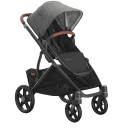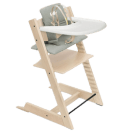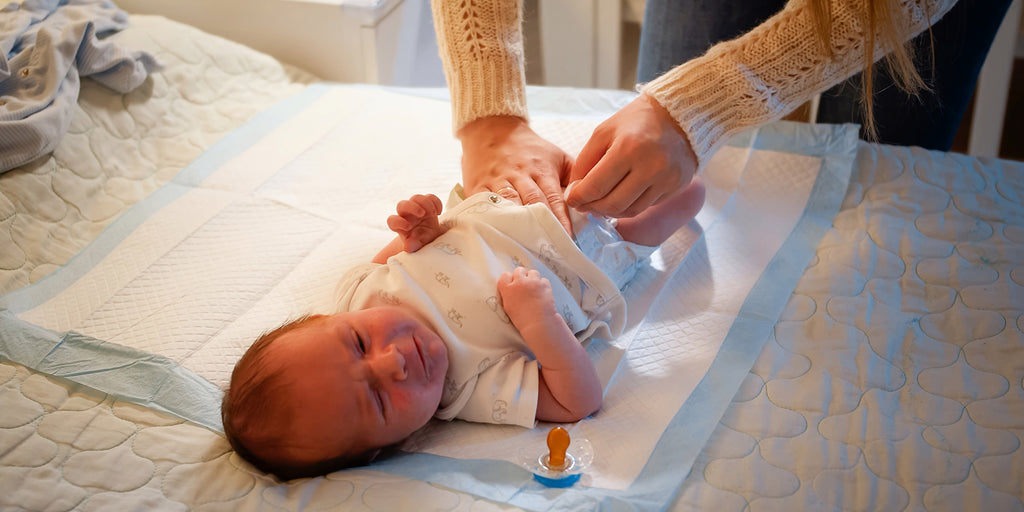
Welcoming a newborn into your family is one of the most joyous moments in life. As a parent, you want to ensure that your little one is always healthy and safe. And one of the most essential aspects of newborn care is safe sleeping. Experts recommend that newborns should always sleep on their backs to reduce the risk of sudden infant death syndrome (SIDS). This isn’t just another parenting fad: Years of research demonstrate that back sleeping affords your little one greater protection against SIDS. Let’s explore the importance of back sleeping for newborns, the reasons for this recommendation, and how to ensure back sleeping works for your little one.
A Little BACKstory
For generations, babies were put to sleep in a variety of positions—on their backs, sides, and even their stomachs. It wasn’t until the 1990s that a significant shift occurred, thanks to the National Institute of Child Health and Development’s (NICHD) “Back to Sleep” campaign (now known as “Safe to Sleep”). This initiative was launched after research unmistakably linked back sleeping to a dramatic reduction in the risk of Sudden Infant Death Syndrome (SIDS). Since then, advising parents to lay their babies on their backs to sleep has become a cornerstone of newborn care.
The Science Behind Back Sleeping
Why is back sleeping so much safer for newborns and infants? Understanding why this position benefits safe sleep requires an understanding of your newborn’s physiology and the risks associated with tummy and side sleeping.
Enhanced Airway Protection
Newborns, with their still-developing anatomy, have smaller airways than adults. Gravity helps open the airway naturally when a baby sleeps on their back. This position aligns the trachea (windpipe) above the esophagus (the tube that carries food to the stomach), reducing the risk of aspiration and facilitating easier breathing. In contrast, when a baby sleeps on their stomach, the airway can become compressed or partially blocked, making breathing more laborious and less efficient. This reduced airflow can lead to lower oxygen levels and higher carbon dioxide levels in the baby’s blood. These conditions are particularly risky during the critical developmental stages of early life.
Prevention of Rebreathing
If your baby continuously breathes in the air they’ve just exhaled, it’s called rebreathing. Why is rebreathing a concern? It can lead to an increase in carbon dioxide intake and a decrease in blood oxygen. Placing your newborn down to sleep on their side or stomach positions their face closer to the mattress, creating a pocket of exhaled air and increasing the risk for rebreathing. By placing your baby to sleep on their back, their nose and mouth are less likely to be obstructed by bedding, reducing the risk of rebreathing and promoting better air circulation around your baby’s face.
Support for Physiological Regulation
Back sleeping supports better physiological regulation for infants, including respiration, oxygenation, temperature regulation, and, most importantly, your baby’s ability to awaken in response to breathing difficulties. Babies who sleep on their backs have better arousal mechanisms during sleep, a critical physiological response that can protect against SIDS. Improved arousal may be due to the more consistent and less obstructed breathing that back sleeping promotes.
Alignment with International Recommendations
The recommendations for back sleeping are supported by extensive research and are promoted by major health organizations worldwide, including the American Academy of Pediatrics (AAP) and the World Health Organization (WHO). These guidelines are not arbitrary but are based on solid evidence linking back sleeping to a significant reduction in the incidence of SIDS.
Dispelling Back Sleeping Myths
Let’s chat about some common concerns you might have with your baby sleeping on their back and why, despite these worries, it’s still the best choice for your little one.
Your Baby Won’t Sleep Well
You might notice your baby seems to wake up more often when they’re sleeping on their back. And it’s not your sleep deprivation playing tricks on you—babies do tend to sleep more soundly on their stomachs. Why? Researchers believe stomach sleeping may dull arousal and prevent your baby from waking up during regular sleep apnea episodes. It’s one of the reasons that the stomach sleeping position is associated with the highest risk of SIDS.
But here’s the silver lining: Waking up easily is actually a good sign. It means your baby is more alert, which is why back sleeping is safer than tummy sleeping. Sure, we all long for a bit more shut-eye, but remember, a bit more wakefulness now is worth it for your baby’s safety. Hang in there—longer stretches of sleep are on the horizon.
Your Baby May Choke on Spit-Up and Vomit
Feeling anxious about your baby spitting up and choking while on their back is common fear among parents. But you can take a deep breath and relax. Babies are pretty clever—if they do spit up, they instinctively know how to turn their heads to clear their airways. And here’s a twist: Sleeping on their stomach actually increases the chances of choking.
Your Baby Will Develop Flat Spots on Their Head
One minor side effect of the “Safe to Sleep” campaign has been an uptick in cases of positional plagiocephaly, or in simpler terms, flat spots on babies’ heads from laying on their backs to sleep. Fortunately, there are a few ways to minimize the chance of your little one developing a flat spot.
A newborn’s skull still has soft spots (fontanels) that haven’t yet grown together, so your baby’s head shape isn’t set in stone. Ensuring they spend plenty of time in varying positions can help prevent flat spots. Switch up which way your baby is facing each time they’re laid down, awake or asleep. And loading up on tummy time and other non-back positions when they’re awake is a solid strategy to ward off any flat spots or odd shapes from developing.
Your Baby Will Have Delayed Motor Milestones
There’s a common misconception that putting your baby to sleep on their back might lead to delayed motor milestones, like rolling over, sitting up, or crawling—but the truth is a bit more reassuring. Research shows that while back-sleeping babies might start certain motor activities slightly later than their tummy-sleeping peers, they catch up with no long-term differences in their development. Plus, back sleeping is significantly safer and reduces the risk of SIDS, making it the recommended position by health experts. So, while your baby might take an extra week or two to show off their new rolling or sitting skills, they’re on a safe and healthy path, which is what matters most.
Making Back Sleeping Work for Your Baby
Ensuring your newborn sleeps on their back might seem straightforward, but it can be challenging, especially if your little one seems to prefer another position. Here are a few tips to make back sleeping a success:
- Create a comfortable and safe sleep environment. Use a firm, flat mattress in a crib, bassinet, or play yard, covered by a fitted sheet with no other bedding or soft objects in the crib. Consider using a sound machine—white noise may help your baby fall (and stay) asleep.
- Establish a bedtime routine. Consistent bedtime rituals can signal to your baby that it’s time to sleep, and can help make back sleeping less of a challenge.
- Swaddle for comfort and security. Swaddling can help soothe your baby and prevent the startle reflex that might wake them up. Just make sure to keep the swaddle snug around the chest, with the hips and legs loose enough to allow movement, and always place your swaddled baby on their back.
- Use a pacifier. Pacifiers can help soothe your baby and have been linked to a reduced risk for SIDS.
- Encourage plenty of tummy time during the day. To prevent flat spots and promote muscle development, engage your baby in supervised tummy time while they’re awake. Tummy time strengthens their neck, shoulder, and arm muscles and provides a nice break from the back sleeping position.
Back Sleeping for Newborns FAQs
Q. Can your baby choke on spit-up while sleeping?
- It’s a common worry, but here’s a comforting fact: Our bodies are naturally designed to prevent this from happening. When babies are on their backs, their airway (trachea) sits above the esophagus (that’s the tube food goes down). So, if they spit up, gravity helps to keep that spit-up in the esophagus and away from the airway, reducing the risk of choking.
Q. When is SIDS no longer a risk?
- SIDS is most concerning in the first year of life, with the highest risk period being between 1 and 4 months of age. Thankfully, the risk significantly decreases after your baby turns one. That said, following safe sleep practices throughout that first year is still super important to keep your little one as safe as possible.
Q. Does swaddling reduce your baby’s risk for SIDS?
- Swaddling can indeed help reduce the risk of SIDS, especially when combined with placing your baby on their back to sleep. It keeps them cozy and prevents their startle reflex from waking them up. Just remember to swaddle properly—not too tight, especially around those tiny hips and legs, and always, always put your swaddled baby to sleep on their back.
Q. Is it okay for your baby to roll to their stomach while sleeping?
- Once your baby starts rolling both ways on their own, usually around 4 to 6 months, it’s okay if they shift into their favorite position, even if it’s on their stomach. By this age, they’re better at repositioning their head and are less at risk. Of course, you should always start them off on their back when you put them down to sleep.
Q. Why is back sleeping best for newborns?
- Back sleeping is the ultimate safe sleep position for babies. It keeps their airways open, reduces the risk of choking, and minimizes the chances of SIDS. It’s all about making sure your little one is sleeping in the safest way possible so they (and you) can rest easy.
Q. Can you prevent your baby from developing a flat spot?
- You can definitely minimize the likelihood. While back sleeping is the safest, it does mean your baby might spend a lot of time with the back of their head against a firm, flat surface. To help prevent flat spots, give your baby plenty of tummy time when they’re awake. This strengthens their neck and shoulder muscles and gives their head a break from pressure. Plus, try to switch up the direction your baby lies in the crib and hold them often—cuddles are a great way to keep that little noggin round.
Finding What’s Right for You
Albee Baby is the oldest family-owned specialty baby shop in the US, and we pride ourselves on providing our customers with the best assortment of baby products anywhere, at fair prices, always. We’re committed to being an inclusive resource for parents and hope you feel empowered to find the right baby gear for your family. Still have questions? Feel free to contact our baby gear experts at 877.692.5233 or info@albeebaby.com
 Car Seat Sale
Car Seat Sale
 Stroller Sale
Stroller Sale
 Home Sale
Home Sale
 Feeding Sale
Feeding Sale
 Activity & Entertainment Sale
Activity & Entertainment Sale
 Bath & Potty Sale
Bath & Potty Sale






 Car Seats
>
Car Seats
>
 Strollers
>
Strollers
>
 Cribs
Cribs
 High Chairs
High Chairs
 Baby Carriers
Baby Carriers
 Travel Cribs & Playards
Travel Cribs & Playards
 Wagons
Wagons
 Home
>
Home
>
 Bath & Potty
>
Bath & Potty
>
 Diaper Bags & Backpacks
Diaper Bags & Backpacks
 Toys
>
Toys
>
 Gifts
>
Gifts
>
 Clothing
>
Clothing
>

















 Infant Car Seats
Infant Car Seats
 Convertible Car Seats
Convertible Car Seats
 All-in-One Car Seats
All-in-One Car Seats
 Booster Car Seats
>
Booster Car Seats
>
 Travel Systems
Travel Systems
 Car Seat Accessories
Car Seat Accessories
 Single Strollers
Single Strollers
 Double Strollers
Double Strollers
 Single-to-Double Strollers
Single-to-Double Strollers
 Lightweight & Compact Strollers
Lightweight & Compact Strollers
 Jogging Strollers
Jogging Strollers
 Bicycle Trailers & Child Seats
Bicycle Trailers & Child Seats
 Stroller Accessories
Stroller Accessories
 Stroller Frames
Stroller Frames



































